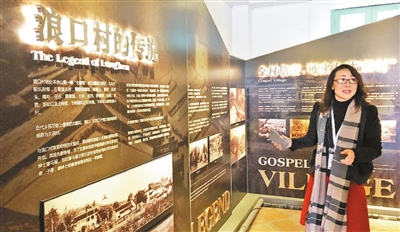
Zhang Qian zhqcindy@163.com IN the heart of Langkou Village, a traditional Hakka village in Longhua District, stands several unique buildings that feature a combination of both Chinese and Western architectural characteristics. The buildings were originally a school campus built by Swiss missionaries and now serve as an venue for passing on the special history where Hakka and Western cultures intersected more than 100 years ago. An exhibition, “Migrations: Home and Elsewhere” that aims to rediscover Hakka history and Chinese-Western cultural exchange, is underway at Langkou Village until Feb. 4. Langkou Village, also dubbed Longheu Village in Hakka dialect, is an authentic Hakka historical site that has been growing from two large families since the Qing Dynasty (1644-1912). The two clans have built ancestral halls and temples, single-story homes and Western towers. Since the reform and opening up about four decades ago, many residents in the village have also built new modern buildings, known as “handshake” buildings. From 1847 to 1949, an international religious organization named Basel Mission sent nearly 200 missionaries to Guangdong. They evangelized, set up schools, established hospitals and lived in Hakka villages over the century. Back in the mid-1800s, missionaries from the Basel Mission arrived at Longheu Village to preach to the local residents. The fusion of Western civilization and Hakka culture was sealed through sharing the mundane details of everyday life such as drinking tea, conversation over shared meals and education. Gradually, children — especially girls — at the village started to receive education from the missionaries, and other conceptual changes took place among the residents as well. Vice-versa, the missionaries incorporated Hakka culture into their lives and their memories of Hakka villages also shaped their European lives. Through increased contact with the missionaries, as well as through remittances from overseas relatives, Longheu Village transformed from a small Hakka village into a village with Western houses and high-quality homes. Luckily, the missionaries’ children have preserved many of the objects that their parents brought back to Europe when they left China. Hearing that an exhibition was going to be held at Dalang, many descendants of the missionaries mailed valuable objects such as textbooks, Hakka-English dictionaries compiled by the missionaries and photos to be displayed at the exhibition. Some descendants even recorded videos to share their memories of living in the Hakka village when they were very young and many can still speak Hakka dialect. Among all of the artifacts that recorded the special period, the remaining and renovated Longheu Pious Virgins Girls’ School is the best for retelling the stories of how Hakka and Western cultures merged. In 1891, a school established by the Basil Mission in Hong Kong was relocated to Longheu Village and was renamed the Longheu Girls’ School. The buildings of the school underwent expansion several times to house more students. The school later also accepted boys with combined traditional Chinese and Western subjects. The latest renovation work on the school was conducted in 2015 by the local government and the school is now an exhibiting venue. Stories of several devoted Western missionaries and their achievements to enhance local villagers’ life are also on exhibit at the village. | 
